Stepping out for the very first time
Page 59
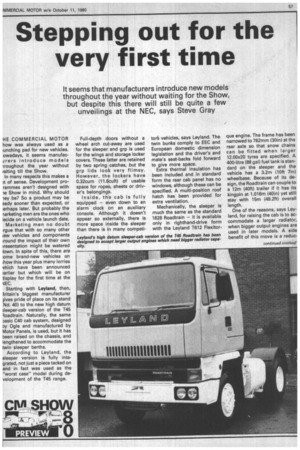
Page 60
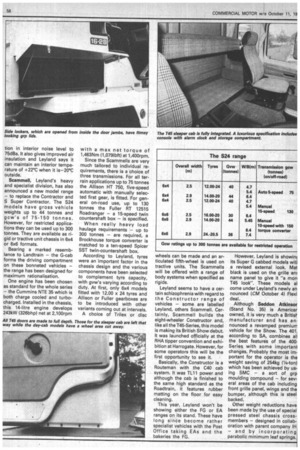
Page 61
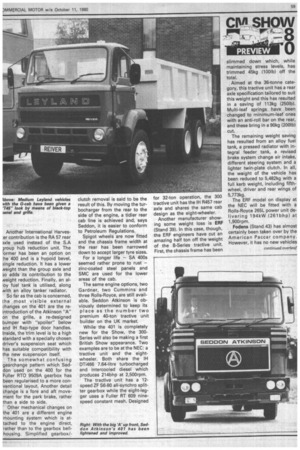
Page 62
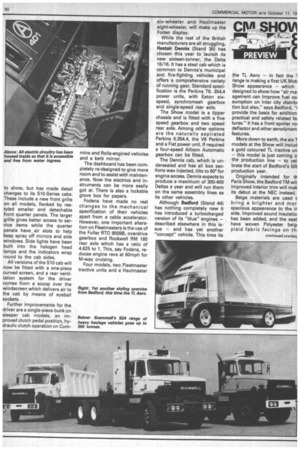
Page 65
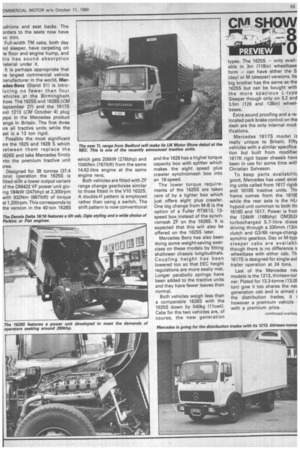
If you've noticed an error in this article please click here to report it so we can fix it.
It seems that manufacturers introduce new models throughout the year without waiting for the Show, but despite this there will still be quite a few unveilings at the NEC, says Steve Gray
HE COMMERCIAL MOTOR how was always used as a lunching pad for new vehicles. owadays, it seems manufac..irers introduce models Iroughout the year without faiting till the Show.
In many respects this makes a )t of sense. Development pro
rammes aren't designed with ie Show in mind. Why should -ley be? So a product may be .9ady sooner than expected, or ,erhaps later. But probably the larketing men are the ones who lecide on a vehicle launch date.
Marketing men no doubt rgue that with so many other iew vehicles and components iround the impact of their own Kesentation might be watered town. In spite of this, there are ;ome brand-new vehicles on ;how this year plus many lorries vhich have been announced )arlier but which will be on iisplay for the first time at the NIEC.
Starting with Leyland, then, 3ritain's biggest manufacturer jives pride of place on its stand NO. 40) to the new high datum ileeper-cab version of the T45 Roadtrain. Naturally, the same aasic C40 cab system, designed Dy Ogle and manufactured by Motor Panels, is used, but it has been raised on the chassis, and lengthened to accommodate the twin sleeper berths.
According to Leyland, the sleeper version is fully integrated, not just a piece tacked on and in fact was used as the "worst case" model during development of the T45 range. Full-depth doors without a wheel arch cut-away are used for the sleeper and grp is used for the wings and storage locker covers. These latter are retained by two spring catches, but the grp lids look very flimsy. However, the lockers have 0.32cum (11.6cuft) of usable space for ropes, sheets or driver's belongings.
Inside, the cab is fully equipped — even down to an alarm clock on an auxiliary console. Although it doesn't appear so externally, there is more space inside the sleeper than there is in many competi
toth vehicles, says Leyland. The twin bunks comply to EEC and European domestic dimension legislation and the driver's and mate's seat-backs fold forward to give more space. Extra thermal insulation has been included and in standard form the rear cab panel has no windows, although these can be specified. A multi-position roof hatch has been provided for extra ventilation.
Mechanically, the sleeper is much the same as the standard 1628 Roadtrain — it is available only in righthand-drive form with the Leyland T612 Flexitor
que engine. The frame has been narrowed to 762mm (30in) at the rear axle so that snow chains can be fitted when larger 12.00x20 tyres are specified. A 400-litre (88 gal) fuel tank is standard on the sleeper and the vehicle has a 3.2m (10ft 7in) wheelbase. Because of its design, the Roadtrain can couple to a 12m (40ft) trailer if it has its kingpin at 1.016m (40in) yet still stay with 15m (49.2ft) overall length.
One of the reasons, says Leyland, for raising the cab is to accommodate a larger radiator, when bigger output engines are used in later models. A side benefit of this move is a reduc tion in interior noise level to 75dBa. It also gives improved air insulation and Leyland says it can maintain an interior temperature of +22°C when it is-20°C outside.
Scammell, Leyland's heavy and specialist division, has also announced a new model range — to replace the Contractor and S Super Contractor. The S24 models have gross vehicle weights up to 44 tonnes and gcw's of 75-150 tonnes. However, for restricted applications they can be used up to 300 tonnes. They are available as rigid or tractive unit chassis in 6x4 or 6x6 formats.
Bearing a marked resemblance to Landtrain — the G-cab forms the driving compartment on these bonneted vehicles — the range has been designed for maximum rationalisation.
One engine has been chosen as standard for the whole series — the Cummins NTE 35 which is both charge cooled and turbocharged. Installed in the chassis, this 14-litre engine develops 243kW (326bhp) net at 2,100rpm with a max net torque of 1,463Nm (1,079Ibft) at 1,400rpm.
Since the Scammells are very much tailored to individual requirements, there is a choice of three transmissions. For all terrain applications up to 75 tonnes the Allison HT 750, five-speed automatic with manually selected first gear, is fitted. For general on-road use, up to 130 tonnes the Fuller RT 12515 Roadranger — a 15-speed twin countershaft box — is specified.
When really heavy load haulage requirements — up to 300 tonnes — are required, a Brockhouse torque converter is matched to a ten-speed Spicer SST twin-countershaft box.
According to Leyland, tyres were an 'important factor in the chassis design and the various components have been selected to complement tyre capacity, with gvw's varying according to duty. At first, only 6x4 models fitted with 12.00 x 24 tyres and Allison or Fuller gearboxes are to be introduced with other variants coming out at intervals.
A choice of Trilex or disc wheels can be made and an articulated fifth-wheel is used on tractive units. The Scammells will be offered with a range of body systems when specified as rigids.
Leyland seems to have a certain schizophrenia with regard to the Constructor range of vehicles — some are labelled Leyland, others Scammell. Certainly, Scammell builds the eight-wheeler Constructor and, like all the T45-Series, this model is making its British Show debut. It was launched officially at the RHA tipper convention and exhibition at Harrogate. However, for some operators this will be the first opportunity to see it.
Basically, the Constructor is a Routeman with the C40 cab system. It was TL11 power and although the cab is finished to the same high standard as the Roadtrain, it features rubber matting on the floor for easy cleaning.
This year, Leyland won't be showing either the FG or EA ranges on its stand. These have long since become rather specialist vehicles with the Post Office taking EAs and the bakeries the FG. However, Leyland is showinc its Super G cabbed models witl a revised external look. Mat black is used on the grille am name panel to give it "a mon T45 look". These models al come under Leyland's newly an nounced (CM October 4) Flexi deal.
Although Seddon Atkinsor (Stand No. 35) is Americar owned, it is very much a British manufacturer and has an nounced a revamped premium vehicle for the Show. The 401, according to SA, combines all the best features of the 400Series with some important changes. Probably the most important for the operator is the weight saving of 254kg (1/4-ton) which has been achieved by using SMC — a sort of grp moulding compound — for several areas of the cab including front grille panel, wings and the bumper, although this is steel backed.
Other weight reductions have been made by the use of special pressed steel chassis crossmembers — designed in collaboration with parent company IH — and by incorporating parabolic minimum leaf springs.
Another International Nerves
• er contribution is the RA 57 rear axle used instead of the S.A jroup hub reduction unit. The 'ormer has been an option on he 400 and is a hypoid bevel, single reduction. It has a lower Neight than the group axle and 30 adds its contribution to the Neight reduction. Finally, an alloy fuel tank is utilised, along Nith an alloy tanker radiator.
So far as the cab is concerned, the most visible external changes on the 401 are the reintroduction of the Atkinson "A" on the grille, a re-designed bumper with "spoiler" below and IH flap-type door handles. Inside, the trim level is to a high standard with a specially chosen driver's suspension seat which has suitable compatibility with the new suspension itself.
The somewhat confusing gearchange pattern which Seddon used on the 400 for the Fuller RTO 9509A gearbox has been regularised to a more conventional layout. Another detail change is a fore and aft movement for the park brake, rather than a side to side.
Other mechanical changes on the 401 are a different engine mounting system which is attached to the engine direct, rather than to the gearbox bellhousing. Simplified gearbox/
clutch removal is said to be the result of this. By moving the turbocharger from the rear to the side of the engine, a tidier rear cab line is achieved and, says Seddon, it is easier to conform to Petroleum Regulations.
Spigot wheels are now fitted and the chassis frame width at the rear has been narrowed down to accept larger tyre sizes.
For a longer life — SA 400s seemed rather prone to rust — zinc-coated steel panels and SMC are used for the lower areas of the cab.
The same engine options, two Gardner, two Cummins and three Rolls-Royce, are still available. Seddon Atkinson is obviously determined to keep its place as the number two premium 40-ton tractive unit builder on the UK market.
While the 401 is completely new for the Show, the 300Series will also be making a first British Show appearance. Two examples are to be at the NEC: a tractive unit and the eightwheeler. Both share the IH DTi466 7.64-litre turbocharged and intercooled diesel which produces 214bhp at 2,500rpm.
The tractive unit has a 12speed ZF S6-80 ali-synchro splitter gearbox while the eight-legger uses a Fuller RT 609 ninespeed constant mesh. Designed
for 32-ton operation, the 300 tractive unit has the IH R457 rear axle and shares the same cab design as the eight-wheeler.
Another manufacturer showing some weight loss is ERF (Stand 39). In this case, though, the ERF engineers have cut an amazing half ton off the weight of the B-Series tractive unit. First, the chassis frame has been slimmed down which, while maintaining stress levels, has trimmed 45kg (1001b) off the total.
Aimed at the 36-tonne category, this tractive unit has a rear axle specification tailored to suit this weight and this has resulted in a saving of 113kg (250Ib). Multi-leaf springs have been • changed to minimum-leaf ones with an anti-roll bar on the rear, and these bring in a 90kg (2001b) cut.
The remaining weight saving has resulted from an alloy fuel tank, a pressed radiator with integral feeder tank, a revised brake system change air intake, different steering system and a lighter twin-plate clutch. In all, the weight of the vehicle has been reduced to 5,482kg with a full kerb weight, including fifthwheel, driver and rear wings of 5,773kg.
The ERF model on display at the NEC will be fitted with a Rolls-Royce 265L power unit delivering 194kW (261 bhp) at 1,90Orpm.
Fodens (Stand 43) has almost certainly been taken over by the American Paccar company. However, it has no new vehicles to show, but has made detail changes to its S10-Series cabs. These include a new front grille on all models, flanked by restyled smaller and detachable front quarter panels. The larger grille gives better access to service items while the quarter panels have air slots to help keep spray off mirrors and side windows. Side lights have been built into the halogen head lamps and the indicators wrap round to the cab sides.
All versions of the S10 cab will now be fitted with a one-piece curved screen, and a rear ventilation system for the driver comes from a scoop over the windscreen which delivers air to the cab by means of eyeball sockets.
Further improvements for the driver are a single-piece bunk on sleeper cab models, an improved clutch pedal position, hydraulic clutch operation on Cum
mins and Rolls-engined vehicles and a kerb mirror.
The dashboard has been completely re-designed to give more room and to assist with maintenance. Now the electrics and instruments can be more easily got at. There is also a lockable glove box for papers.
Fodens have made no real changes to the mechanical specification of their vehicles apart from a cable accelerator. However, one important alteration on Fleetmasters is the use of the Fuller RTO 9509B, overdrive gearbox and Rockwell RM 180 rear axle which has a ratio of 4.625 to 1. This, say Fodens, reduces engine revs at 60mph for M-way cruising.
Four models, two Fleetmaster tractive units and a Haulmaster six-wheeler and Haulmaster eight-wheeler, will make up the Foden display.
While the rest of the British manufacturers are all struggling, Hestair Dennis (Stand 36) has chosen this year to launch its new sixteen-tonner, the Delta 16/16. It has a steel cab which is common to Dennis's municipal and fire-fighting vehicles and offers a comprehensive variety of running gear. Standard specification is the Perkins T6. 354.4 power units, with Eaton sixspeed, synchromesh gearbox and single-speed rear axle.
The Show model is a tipper chassis and is fitted with a five speed gearbox and two speed rear axle. Among other options are the naturally aspirated Perkins 6.354.4, the V8 Perkins and a Fiat power unit. If required a four-speed Allison Automatic gearbox can be fitted.
The Dennis cab, which is undersealed and has all box sections wax injected, tilts to 60° for engine access. Dennis expects to produce a maximum of 300-400 Deltas a year and will run them on the same assembly lines as its other vehicles.
Although Bedford (Stand 44) has nothing completely new it has introduced a turbocharged version of its "blue" engines — described elsewhere in this issue — and has yet another "concept" vehicle. This time its the TL Aero — in fact the 1 range is making a first UK Mott Show appearance — which designed to show how "air mai agement can improve fuel col sumption on inter city distribi tion but also," says Bedford, "1 provide the basis for addition practical and safety related fe; tures." It has a front spoiler rot deflector and other aerodynam features.
More down to earth, the six 7 models at the Show will includ a gold coloured TL tractive un — this model is just coming o the production line — to cel, brate the start of Bedford's 50t production year.
Originally intended for th Paris Show, the Bedford TM wit improved interior trim will mak its debut at the NEC instead.
Beige materials are used t, bring a brighter and mor
spacious appearance to the ir side. improved sound insulatiol
has been added, and the seat have woven Polyester beig, plaid fabric facings on th,
Jshions and seat backs. The orders to the seats now have vc trim.
Full-width TM cabs, both day nd sleeper, have carpeting on le floor and engine hump, and his has sound absorption laterial under it.
It is perhaps appropriate that -te largest commercial vehicle lanufacturer in the world, Meredes-Benz (Stand 51) is introlucing no fewer than four .ehicles at the Birmingham how. The 1625S and 1628S (CM ieptember 27) and the 1617S ind 1213 (CM October 4) plug laps in the Mercedes product ange in Britain. The first three ire all tractive units while the ast is a 13 ton rigid.
Possibly the most significant ire the 1625 and 1628 S which )etween them replace the I626S and take Mercedes firmly nto the premium tractive unit irea.
Designed for 38 tonnes (37.4 :ons) operation the 16258 is Fitted with a lower output variant pf the 0M422 VF power unit giving 184kW (247bhp) at 2,300rpm with 932Nm (6871bft) of torque at 1,200rpm. This corresponds to the version in the 40-ton 16288 which gets 206kW (276bhp) and 1040Nm (767Ibft) from the same 14.62-litre engine at the same engine revs.
Both vehicles are fitted with ZF range change gearboxes similar to those fitted in the V10 16328. A double-H pattern is employed rather than using a switch. The shift pattern is now conventional and the 1628 has a higher torque capacity box with splitter which makes the eight speed plus crawler synchromesh box into an 18-speed.
The lower torque requirements of the 16258 are taken care of by a lighter box which just offers eight plus crawler. One big change from M-B is the option of a Fuller RT9513, 13speed box instead of the synchromesh ZF on the 1628S. It is expected that this will also be offered on the 1625S later.
Mercedes Benz has also been doing some weight-saving exercises on these models by fitting shallower chassis longitudinals. Coupling height has been lowered too so that EEC height regulations are more easily met. Longer parabolic springs have been added to the tractive units and they have fewer leaves than normal.
Both vehicles weigh less than a comparable 16265 with the 1625S down by 540kg (11cwt). Cabs for the two vehicles are, of course, the new generation types. The 1625S — only available in 3m (1181n) wheelbase form — can have either the S (day) or M (sleeper) versions. Its big brother has the same as the 16258 but can be bought with the more spacious L-type Sleeper though only on 3.2 and 3.5m (126 and 138in) wheelbases.
Extra sound proofing and a relocated park brake control on the dash are the only internal modifications.
Mercedes 1617S model is really unique to Britain. Fifty vehicles with a similar specification but built from modifiec 1617K rigid tipper chassis hays been in use for some time with Christian Salveson.
To keep parts availabilit good, Mercedes has used exist ing units called from 1617 rigid: and 1619S tractive units. Th( frame comes from the 1619; while the rear axle is the HLe hypoid unit common to both th( 1619S and 1617. Power is froh the 124kW (168bhp) 0M352/ turbocharged 5.7-litre diese driving through a 330mm (13in clutch and G3/65 range-cbangt synchro gearbox. Day or M-typt sleeper cabs are availablt though there is no difference it wheelbase with either cab. Th 1617S is designed for single-axl trailer operation at 24 tons.
Last of the Mercedes nel, models is the 1213, thirteen-tor ner. Plated for 13.3-tonne (13.0E ton) gvw it too shares the nes. generation cab and is aimed E the distribution trades. It i however a premium vehicle with a premium price.












































































































































































